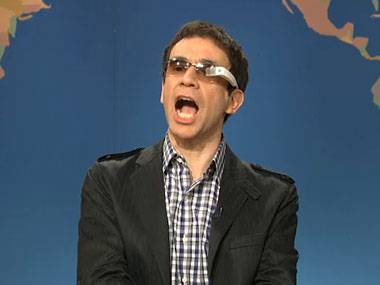If Wearables Are Going to Grow Up, Games Might Point the Way
 In tech circles, the buzz around wearable computing, already a multi-billion dollar market, has never been louder. No one wants to miss the boat if wearable apps are going to be as disruptive as apps for smartphones and tablets, an anxiety reflected well at GDC Next in Los Angeles.
In tech circles, the buzz around wearable computing, already a multi-billion dollar market, has never been louder. No one wants to miss the boat if wearable apps are going to be as disruptive as apps for smartphones and tablets, an anxiety reflected well at GDC Next in Los Angeles.
Conference attendees packed one of the meeting rooms at the Los Angeles Convention Center last week to hear Mind Pirate CEO Shawn Hardin and VP Unni Narayanan pitch games for wearables as the “next consumer mega trend.” But when Hardin asked if any of the developers in the room had made apps for wearable devices, only one raised his hand.
Those devices include glasses like Google Glass, smartwatches like the Pebble and the Samsung Galaxy Gear, and fitness trackers like the Fitbit Flex and Jawbone Up. Despite some early consumer success, particularly for those fitness trackers, advances in wearables have been sluggish so far. As AllThingsD’s Lauren Goode observed in her review of Fitbit’s latest tracker, “the whole product category has moved on to Activity Tracking 1.1, but hasn’t quite graduated to Wearables 2.0.”
Indeed, a different conference session later in the day reinforced this sensation of arrested development. Developer Matthew Morey’s “New Opportunities with Wearable Technology” covered no fewer than thirteen smartwatches, not to mention a wide range of niche gadgets like a fitness tracker for dogs, a Bluetooth-equipped baseball cap and a calorie-counting fork.
“These don’t have to be big problems we’re solving,” Morey said. “It’s these little ones that people really like.”
Mind Pirate, though, is banking on an “inevitability” that the hardware and software will catch up to the dreams of wearables proponents and become as ubiquitous as phones and tablets. Its game and app development platform, Callisto, is about to get a real-world test by way of a partnership with a Canadian business accelerator, ideaBoost. The two organizations hope to have Callisto-produced entertainment apps for wearables in the wild next year, as early as the end of ideaBoost’s next class in Q1 2014.
Rather than trying to solve consumers’ problems, the idea is that entertaining apps will validate new categories of devices for consumers, which you could argue was a big chunk of the mobile story as well. Getting in front of games for devices like Google Glass may mean helping to figure out just what, exactly, a world of omnipresent games would look like.
“There’s an entirely new class of games that you could design,” Hardin said. “The world itself becomes the game board.”
Buried in these ambitions seems to be the assumption that touchscreens are now passé. Smartphones, Hardin said in his introduction, are “loaded with a bunch of sensors,” but 90 percent of the top-grossing iOS and Android mobile games only use the touchscreen. IdeaBoost’s chief digital officer Ana Serrano echoed this sentiment in a separate interview, saying the world is “moving beyond the multitouch user experience paradigm into something completely different.”
The question is whether games succeed in spite of their only using touch, or whether touch is just more intuitive and therefore a better way to reach a mass consumer audience. Mind Pirate said ported games won’t be pleasant — they will have to be designed specifically for wearables.
“Any game can be adapted in a native, reliable fashion if the designer puts a lot of thought into it,” Hardin’s colleague Narayanan said during the panel, with the caveat that wearable games experiences probably should not exceed two minutes per play session. “Barring a first-person-shooter that’s a 20-minute experience …”
Also left to be determined is if and how Wearables 2.0 will fit into a world already bogged down by hardware. In the “New Opportunities” panel, Morey acknowledged that “charging a Pebble every night is not an enjoyable experience.”
His prescription for extending the battery life of wearables: “Harvesting power from the human body.” As in, embedding the technology under one’s skin and generating energy from the temperature difference inside and out.
If that sounds a bit icky to you, then don’t click this. The short version: a German “biohacker” has already undergone surgery to stitch a Bluetooth-compatible device under the skin of his left forearm.
This underscores the gap between the technologically feasible and the broadly acceptable. In his panel, Hardin readily volunteered that how more-advanced wearables will fit into society is still a work in progress, but that the devices will inevitably “thread their way through our lives and make new [social] mores.” If he and his company are right, games will help build that bridge with consumers and make being a cyborg just as normal as playing Candy Crush on the train.









